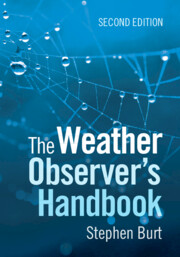Book contents
- The Weather Observer’s Handbook
- Reviews
- The Weather Observer’s Handbook
- Copyright page
- Dedication
- Epigraph
- Contents
- Foreword
- Acknowledgements
- Author’s note
- Abbreviations, footnotes and references
- Part I The basics
- Part II Measuring the weather
- 4 Site and exposure: The basics
- 5 Measuring the temperature of the air
- 6 Measuring precipitation
- 7 Measuring atmospheric pressure
- 8 Measuring humidity
- 9 Measuring wind speed and direction
- 10 Measuring grass and earth temperatures
- 11 Measuring sunshine and solar radiation
- 12 Observing hours and time standards
- 13 AWS data flows, display and storage
- 14 Non-instrumental weather observing
- 15 Calibration
- 16 Metadata: What is it, and why is it important?
- Part III Making the most of your observations
- Book part
- References and Further Reading
- Index
13 - AWS data flows, display and storage
from Part II - Measuring the weather
Published online by Cambridge University Press: 21 May 2024
- The Weather Observer’s Handbook
- Reviews
- The Weather Observer’s Handbook
- Copyright page
- Dedication
- Epigraph
- Contents
- Foreword
- Acknowledgements
- Author’s note
- Abbreviations, footnotes and references
- Part I The basics
- Part II Measuring the weather
- 4 Site and exposure: The basics
- 5 Measuring the temperature of the air
- 6 Measuring precipitation
- 7 Measuring atmospheric pressure
- 8 Measuring humidity
- 9 Measuring wind speed and direction
- 10 Measuring grass and earth temperatures
- 11 Measuring sunshine and solar radiation
- 12 Observing hours and time standards
- 13 AWS data flows, display and storage
- 14 Non-instrumental weather observing
- 15 Calibration
- 16 Metadata: What is it, and why is it important?
- Part III Making the most of your observations
- Book part
- References and Further Reading
- Index
Summary
A modern automatic weather station (AWS) is a sophisticated collection of various components, sensors and electronics modules tied together by software, together making up a data acquisition and processing system. Many of today and tomorrow’s products follow a broadly similar set of basic processes, and this chapter sets out to explain these basic processing steps, keeping technical terminology to a minimum, and illustrating three different approaches to ‘system architecture’. The oversight provided by this chapter provides familiarity with the key concepts, system approaches and application types, and from there users can review potential products and suppliers using Internet search facilities to gather up-to-date product information.
Keywords
Information
- Type
- Chapter
- Information
- The Weather Observer's Handbook , pp. 314 - 323Publisher: Cambridge University PressPrint publication year: 2024
